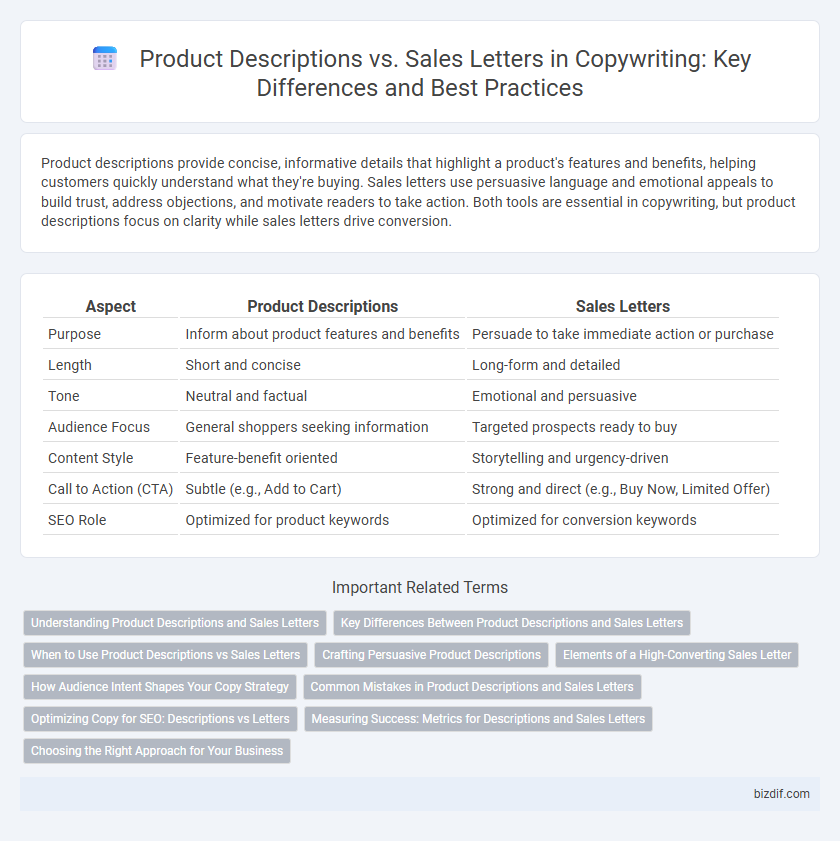Product descriptions provide concise, informative details that highlight a product's features and benefits, helping customers quickly understand what they're buying. Sales letters use persuasive language and emotional appeals to build trust, address objections, and motivate readers to take action. Both tools are essential in copywriting, but product descriptions focus on clarity while sales letters drive conversion.
Table of Comparison
| Aspect | Product Descriptions | Sales Letters |
|---|---|---|
| Purpose | Inform about product features and benefits | Persuade to take immediate action or purchase |
| Length | Short and concise | Long-form and detailed |
| Tone | Neutral and factual | Emotional and persuasive |
| Audience Focus | General shoppers seeking information | Targeted prospects ready to buy |
| Content Style | Feature-benefit oriented | Storytelling and urgency-driven |
| Call to Action (CTA) | Subtle (e.g., Add to Cart) | Strong and direct (e.g., Buy Now, Limited Offer) |
| SEO Role | Optimized for product keywords | Optimized for conversion keywords |
Understanding Product Descriptions and Sales Letters
Product descriptions provide concise, factual information about a product's features, benefits, and specifications to inform potential buyers and drive purchase decisions. Sales letters use persuasive language and emotional appeal to engage readers, build trust, and motivate immediate action, often including strong calls-to-action and social proof. Understanding the distinct objectives and tone of each helps copywriters craft content that effectively targets customer needs and sales goals.
Key Differences Between Product Descriptions and Sales Letters
Product descriptions provide concise, factual details about a product's features, specifications, and benefits to inform potential buyers quickly. Sales letters use persuasive language and storytelling techniques to engage readers, evoke emotions, and drive conversions by addressing pain points and offering solutions. The core difference lies in product descriptions focusing on information delivery, while sales letters aim to motivate action through persuasive communication.
When to Use Product Descriptions vs Sales Letters
Use product descriptions when showcasing individual items on e-commerce sites, as they provide concise, detailed information that highlights features and specifications to inform potential buyers quickly. Opt for sales letters in email marketing or landing pages where a persuasive, narrative-driven approach aims to build desire, address objections, and prompt immediate action. Product descriptions excel at scannability and clarity, while sales letters are ideal for emotionally engaging customers and driving conversions through storytelling and targeted calls to action.
Crafting Persuasive Product Descriptions
Crafting persuasive product descriptions requires focusing on clear benefits, vivid imagery, and emotional appeal to connect with potential buyers instantly. Unlike sales letters, product descriptions should be concise, highlighting key features and unique selling points that address customer needs and pain points. Optimizing these descriptions with relevant keywords and compelling calls-to-action boosts conversion rates and search engine visibility.
Elements of a High-Converting Sales Letter
High-converting sales letters incorporate persuasive storytelling, strong emotional triggers, and clear calls-to-action that drive reader engagement and conversion. Key elements include a compelling headline, social proof such as testimonials, risk-reversal guarantees, and an emphasis on benefits rather than just features. Unlike product descriptions, sales letters focus on creating urgency and building trust to maximize sales impact.
How Audience Intent Shapes Your Copy Strategy
Product descriptions target consumers with high purchase intent by highlighting features, benefits, and specifications to facilitate quick decision-making. Sales letters engage prospects earlier in the buying journey, using persuasive storytelling and emotional triggers to build desire and address objections. Understanding audience intent allows copywriters to tailor messaging, tone, and call-to-actions for maximum conversion effectiveness.
Common Mistakes in Product Descriptions and Sales Letters
Common mistakes in product descriptions include using vague language, failing to highlight key benefits, and neglecting to address customer pain points effectively. Sales letters often fall short by lacking a compelling call-to-action, being overly lengthy, or not establishing a clear emotional connection with the reader. Both types of copy should focus on clarity, persuasive messaging, and targeted audience engagement to maximize conversion rates.
Optimizing Copy for SEO: Descriptions vs Letters
Product descriptions focus on concise, keyword-rich content that highlights features and benefits to improve search engine rankings and attract targeted traffic. Sales letters emphasize persuasive storytelling and emotional triggers, often incorporating keywords strategically to balance SEO with conversion-focused messaging. Optimizing copy for SEO in descriptions requires clear structure and relevant terms, while sales letters demand engaging, keyword-integrated narratives that drive action.
Measuring Success: Metrics for Descriptions and Sales Letters
Product descriptions are evaluated primarily through metrics such as click-through rates, conversion rates, and average time on page, which indicate how effectively the description drives initial interest and purchases. Sales letters, on the other hand, rely on measuring open rates, direct response rates, and return on investment (ROI) to assess their ability to engage and persuade subscribers or leads toward buying. Tracking these targeted KPIs ensures optimized performance tailored to the distinct goals of product descriptions and sales letters in copywriting campaigns.
Choosing the Right Approach for Your Business
Product descriptions highlight features, benefits, and specifications to inform potential customers and enhance SEO, making them ideal for e-commerce platforms aiming to boost online visibility. Sales letters focus on persuasive storytelling and emotional appeals to drive immediate action, suited for direct marketing campaigns targeting specific buyer personas. Selecting the right approach depends on your business goals, target audience, and sales funnel stage to maximize conversion rates and brand impact.
Product Descriptions vs Sales Letters Infographic

 bizdif.com
bizdif.com